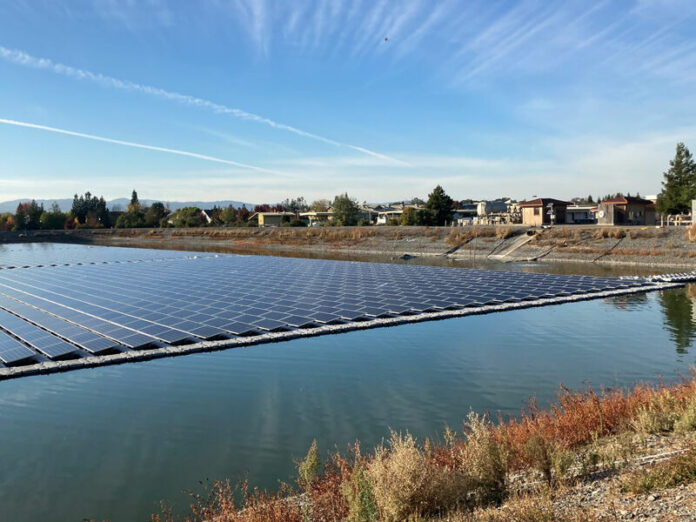
The town of Windsor announced on Nov. 17 that its floating solar array system had “successfully completed the testing phase and is now fully energized and online. Operation of this new floating solar array, the largest in California, will reduce Town GHG emissions by 350 metric tons of CO2 per year and save approximately $5 million dollars in energy costs over the next 25 years.”
Construction on the array started in May of 2019, and represented a partnership with Ciel & Terre, a French solar company, working with local union contractor, Collins Electrical Company, on the town’s largest recycled water Pond 7.
The solar installation consists of 4,959 (360W) high-output solar panels mounted atop a floating solar racking system. The solar power system will generate power for the Windsor Wastewater Reclamation Facility, Public Works Corporation Yard and the Geysers pump station, delivering approximately 90% of the water reclamation facilities’ power requirements while saving about 30% of the electricity cost based on the facilities’ existing grid service, according to the town.
“Our water reclamation and corporation yard facilities currently account for 40% of the town’s greenhouse gas emissions,” said Toni Bertolero, town of Windsor public works director at the start of the construction. “Installation of this new floating solar array will reduce our reliance on energy-polluting sources by an estimated 350 metric tons of CO2 per year, a significant step to achieve our Climate Action Plan emission reduction goals.”
The project did not cost the town anything, since Ciel & Terre entered into a 25-year lease and power purchase agreement (PPA) with the town of Windsor to provide discounted clean energy.
The floating solar system will allow Windsor to better control its electrical costs in the face of rising utility prices. “By entering into a PPA, the town can substantially reduce its energy overhead without any investment,” said Eva Pauly-Bowles, representative director for Ciel & Terre USA, Inc. in 2019. “Floating solar is becoming an attractive energy alternative for municipalities seeking to reduce operating costs and preserve valuable land for other developments.”
The array covers approximately four acres, or 22%, of the pond water surface area. It will have no adverse impacts on pond biology and will reduce water loss from evaporation and inhibit algae growth. The state-of-the-art floating solar design can be expanded for extra capacity and did not affect water reclamation facilities operations while it is being installed.








